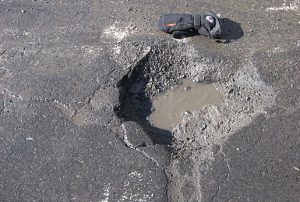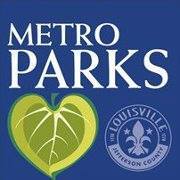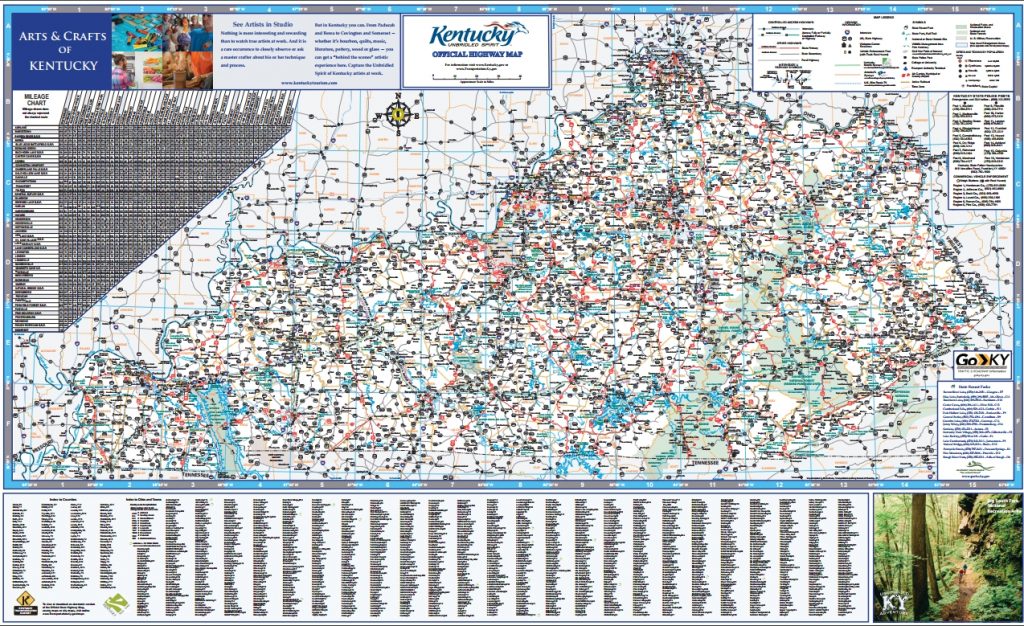 Mayor Greg Fischer today helped launch the 2017 edition of the Pothole Blitz conducted annually by Metro Public Works. During the blitz, to recover from damage caused by the multiple freeze/thaw cycles of winter, Public Works crews go through the city’s streets in a grid pattern patching potholes until all roads are covered.
Mayor Greg Fischer today helped launch the 2017 edition of the Pothole Blitz conducted annually by Metro Public Works. During the blitz, to recover from damage caused by the multiple freeze/thaw cycles of winter, Public Works crews go through the city’s streets in a grid pattern patching potholes until all roads are covered.
Mayor Fischer noted that the number of potholes is expected to continue a decline begun last year thanks to increased investment in paving and consecutive mild winters. Potholes peaked at 171,000 in 2015 following years of deferred road maintenance and a rough winter. But they are expected to total less than 50,000 in 2017.
Potholes can be reported to Metro Public Works here and other drivers can be warned and pothole information can be shared on the Operation Fill Louisville Potholes Facebook page.
The Mayor and Metro Council boosted spending on paving from just $2.8 million in 2014 up to $20.9 million in 2016. As a result, the number of miles paved increased from 26 in 2014 to 131 in 2016. Newly repaved roads are less susceptible to the formation of potholes.
Also this year, Public Works is adding $250,000 worth of new equipment that will help patch potholes faster and more effectively. For instance, vibrating walk-behind plate compactors are replacing handheld compactors to do a better job of pressing newly laid asphalt into place.
Mayor Fischer urged citizens to participate in the blitz by reporting potholes to MetroCall in one of three easy ways. Those using the social network Twitter can use the hashtag 502pothole. Include the hashtag along with the address or nearest intersection of the pothole location in any tweet, and MetroCall will get the message.
The same goes for a pothole reporting form that can be found at the top of the city website, Louisvilleky.gov. Click on the “Report a pothole” link, put in the location information and press send. “We believe government works best in collaboration with citizens,” the Mayor said. “The Twitter and website reporting tools are just another way to make city government even more responsive and easy to work with.” People can also call MetroCall at 311 or 574-5000. The 502pothole hashtag and the online form offer the advantage of avoiding the potential for having to wait on hold on the telephone.
Public Works patches potholes on Metro Government maintained roads. Potholes on interstate highways should be reported to the Kentucky Transportation Cabinet at 1-877-For-KYTC (367-5982).

Photo from KDF
February days in the 60s make for crowded boat ramps and golf courses during a time of year usually spent indoors.
Everything, nature wise, seems a couple of weeks ahead of schedule. Buds show on lilac bushes, green grass already grows in bunches and the sound of lawn mowers permeates an afternoon backyard barbecue.
The rare winter temperatures may alter white bass spawning runs as well.
“With the weather pattern so far, I would be looking at the white bass getting going a little earlier than usual,” said Rob Rold, Northwestern Fisheries District biologist for the Kentucky Department of Fish and Wildlife Resources. “When we’ve had consecutive warm days, the white bass run up a bit into the headwaters above Nolin River Lake, but when it cools they go back down in the lake. They will do false runs until it gets right.”
Water temperatures are in the low 50s on Nolin River Lake, while other lakes such as Taylorsville Lake are flirting with water temperatures in the mid 50s.
“It should be getting close,” said David Baker, Central Fisheries District biologist for Kentucky Fish and Wildlife. “We are doing a creel survey on Herrington and the white bass are staging in the upper one-third of the lake, waiting for the next temperature spike. A good warm front with water temperatures getting into the upper 50s, they will start moving to the shoals in the upper lake of both Herrington and Taylorsville.”
Baker said Herrington gets the nod for size of white bass. “There are a lot of really big white bass in Herrington, many up to 14 inches long. For catching a big white bass, Herrington is better than Taylorsville,” he said. Taylorsville Lake produces numbers of white bass, but less size.
Anglers may access the upper section of Herrington Lake and Dix River via Bryants Camp Boat Ramp in Garrard County. Bank anglers may access the Salt River above Taylorsville Lake via River Road on the Taylorsville Lake Wildlife Management Area until the opening of spring turkey season April 15. Boaters use Van Buren Boat Ramp on Taylorsville Lake.
Nolin River Lake holds arguably the best white bass population in Kentucky.
Rold said the Cane Run area, known to locals as the “Three Fingers,” in the upper lake upstream to Broad Ford at the KY 1214 Bridge is usually where the white bass runs begin.
“The length of day really dictates when they will run, even if it is not the preferred water temperature,” Rold said. “They start staging around Cane Run. It is a bit early, but they will come on soon.”
Rold said bank anglers use the access at Bacon Creek for productive white bass fishing. “Go to Bacon Creek ramp and walk the bank up or down,” he said. “The Corps property goes all the way up past Broad Ford. At winter pool, Broad Ford is the first shoal on Nolin River upstream of the lake.”
The tailwaters downstream of the locks and dams on the lower Green River also provide excellent white bass fishing. “The water below Lock and Dam 1 at Spottsville, Lock and Dam 2 at Calhoun and Lock and Dam 3 at Rochester all have decent white bass,” Rold said. “The mouth of Pond River downstream of Calhoun at Jewel City has a big white bass fishery. They run up into Pond River.”
Anglers may access the mouth via a public boat ramp at Jewel City. The tailwater below Lock and Dam 2 has a boat ramp and limited bank access at the end of Second Street in Rumsey, across the river from Calhoun. The tailwaters below Lock and Dam 3 at Rochester offer excellent bank access just west of town on Boat Ramp Road via KY 70.
The smaller male white bass make the initial runs. You will catch many fish during this time, but most will be of similar size. You often catch fish on consecutive casts when the males are running.
“By the first weeks of April, the females show up and it is prime,” Baker said. “This is the best fishing of spring runs.”
Running white bass hit anything that resembles baitfish with abandon, one of the keys to their enduring popularity. When the spring white bass runs peak, nothing else compares to the furious fishing.
White, chartreuse or gray in-line spinners are hard to beat during the runs, but 2-inch white curly tailed grubs rigged on 1/16-ounce leadheads also produce many white bass. Anglers also suspend 1/32-ounce white and red, pink or yellow feather jigs from 18 to 24 inches deep under small bobbers and allow them to drift in the current. Some anglers tip the feather jigs with small crappie minnows to make them more attractive to white bass.
As the runs peak, small topwater propeller baits draw vicious strikes, but you get more consistent action with subsurface presentations.
The next long sustained warm front will get the white bass running. It is time for the most exciting fishing of the year. Remember to buy your fishing license. The new license year began March 1.
 Mayor Greg Fischer announced changes meant to reduce the role of Louisville Metro Police in providing traffic details and security for special events.
Mayor Greg Fischer announced changes meant to reduce the role of Louisville Metro Police in providing traffic details and security for special events.
Under new guidelines, organizers of special events in the city will be asked to increase volunteer participation during their events for positions that may not require a sworn police officer. Additionally, organizers will be asked to use private security companies when possible. Organizers will also be encouraged to use pre-designated routes that will need a limited or reduced number of sworn law enforcement.
“The sheer number of events throughout the city each week is a sign of vibrancy and community,” Mayor Fischer said. “But we must balance that with the need for LMPD to spend fewer hours covering special events.
“This new process allows our public safety teams to better coordinate with community groups to provide a better experience for participants and other citizens, while freeing up police officers to focus on other pressing needs.”
Earlier this year, the special events permitting process moved to Louisville Metro Emergency Services from Louisville Metro Codes and Regulations. Within Emergency Services, recently appointed Deputy Director Kelly Jones will oversee special events permitting, along with his other duties.
Jones will work with community groups to find appropriate venues for special events, with the goal of reducing LMPD involvement and street closures. The change will also allow for better internal coordination of city services for special events.
Jones retired last year from Louisville Metro Police. His most recent role included leading the city’s law enforcement details for special events, including Thunder Over Louisville and the Kentucky Derby and Oaks. He also played a large role in this past summer’s commemoration of boxing legend Muhammad Ali.
“Louisville Metro is committed to facilitating safe experiences for event participants,” Jones said. “I’m pleased to return to public service, and to lend my experience coordinating logistics and security for events.”
More information about special events policies can be found here: https://louisvilleky.gov/government/emergency-services/special-events

Photo from Louisville Metro Parks and Recreation
Award-winning country/folk band Old Crow Medicine Show will be paying homage to the legendary Bob Dylan when they make a tour stop at the Iroquois Amphitheater on Friday, June 2.
The platinum-selling band, who are two-time Grammy Award winners, are embarking on a 29-date tour, during which they will be playing Dylan’s iconic album Blonde On Blonde in its entirety at each stop.
The band is also promoting its own recreation of the album that was recorded live at the CMA Theater inside the Country Music Hall of Fame and Museum located in Nashville in May 2016. Fans can order the album, titled 50 Years of Blonde on Blonde at the Old Crow Medicine Show online store and everywhere else on Friday, February 24.
Tickets will also go on sale for the show at the Iroquois Amphitheater at 10 a.m. on Friday, February 24 at www.ticketfly.com. Tickets are $39.50 for the uncovered section of the amphitheater and $49.50 for the covered portion.
Fans can also buy tickets at the Iroquois Amphitheater box office, 1080 Amphitheater Road right off New Cut Road in Iroquois Park, from 9 a.m. to 4 p.m. Monday through Friday.
Gates for the show will open at 6:30 p.m. on Friday June 2, and the show will start around 8 p.m. No coolers or outside beverages are allowed inside of the amphitheater, although a full range of concessions, including alcoholic beverages, will be for sale.
Tickets to two other upcoming shows – Shovels and Rope (Friday, May 12) and Louder Than Life Presents: Skillet with Starset and Sylar (Sunday, May 21) will also go on sale at the Tickefly website on Friday morning.
About Old Crow Medicine Show
Old Crow Medicine Show is comprised of members Ketch Secor, Morgan Jahnig, Chance McCoy, Cory Younts, Kevin Hayes and Critter Fuqua. The Country Music Roots band and Grand Ole Opry members have five studio albums to their credit, Old Crow Medicine Show (2004), Big Iron World (2006), Tennessee Pusher (2008), Carry Me Back (2012), Remedy (2014) and appeared on countless albums by other artists. They’ve established a global tour following, received the Americana Music Association Trailblazer Award and shared the stage with artists such as Willie Nelson, Brandi Carlile, Mumford & Sons, The Lumineers, John Prine and The Avett Brothers. The PLATINUM selling band are two-time GRAMMY-winners including Best Folk Album in 2014.
Map celebrates the Commonwealth’s 225th birthday, showcases ‘Kentucky’s Great Lakes’
Featuring the Commonwealth’s expansive waterways, Kentucky’s new road maps will create quite a splash in the upcoming travel season.
The 2017 Official Highway Map – now available at rest areas, welcome centers, local convention and tourism offices and all Kentucky state parks– provides more than directions for its readers.
This year’s map highlights the wealth of recreation and relaxation opportunities presented by “Kentucky’s Great Lakes.” Known internationally for its scenic lakeside shorelines, Kentucky’s vast lake system offers over 360,000 acres for individuals to play and unwind.
The 2017 highway map also celebrates the quasquibicentennial, or the 225th anniversary, of the Commonwealth’s statehood. Founded in 1792, Kentucky boasts a rich history with an exciting, prosperous future.

In his invitation to visit and explore all that Kentucky has to offer, Governor Matt Bevin spoke of the 225 years of memories captured in the Commonwealth.
“Kentucky travelers have long enjoyed the endless opportunities awaiting them along the Commonwealth’s highways and byways,” said Gov. Bevin. “As we celebrate our 225th anniversary this year, we invite residents and visitors alike, to join the fun in exploring all the Bluegrass State has to offer. We extend a warm Kentucky welcome to all who seek arts, history, culture, discovery and adventure—from our western waterlands to our eastern mountains, and all points in between. Thank you for exploring the most beautiful state in America!”
Published annually, the highway map highlights popular travel destinations:
- Berea: Channel the inner artist at the Kentucky Artisan Center.
- Bowling Green: Experience the thrill of the corvette at the National Corvette Museum.
- Danville: Enjoy live stage action at the Pioneer Playhouse, Kentucky’s oldest outdoor dinner theatre.
- Hodgenville: Visit the birthplace of President Abraham Lincoln.
- Louisville: Hear the rumble of charging horses at the home of the Kentucky Derby.
- Paducah: Admire the wall-to-wall murals down by the riverside.
- Slade: Scale the soaring wonders of Natural Bridge State Park.
For individuals with an artistic flair, the map features stopovers like Covington and Somerset where budding artists can get a “behind the scenes” look as artisans demonstrate their craft and bring their ideas to life. For adventurists with a bent toward hiking, bicycling or horseback riding, the map details numerous Kentucky trail towns and pathways ready to be explored. Continue reading

Photo: KHS
Last week, the Kentucky Historical Society (KHS) announced recipients of the first grants from the Kentucky Local History Trust Fund (KRS 171.325), a funding pool that supports local history organizations’ efforts to preserve and tell Kentucky’s stories.
Seventeen organizations from 16 counties across the Commonwealth received grants totaling $9,504.30. Individual amounts range from $290 to $1,000 for projects related to collection conservation, education, promotion, exhibits and strategic planning.
Kentucky Local History Trust Fund grant recipients include:
- Appalshop, Inc., $1,000, Letcher County, for collection management
- Highlands Museum and Discovery Center, $1,000, Boyd County, for collection management
- The Friends of Audubon, $1,000, Henderson County, for exhibit artifact conservation
- Ben E. Clement Mineral Museum, $909, Crittenden County, for educational programming
- McDowell House Museum, Inc., $700, Boyle County, for collections management
- American Printing House for the Blind, $700, Jefferson County, for exhibit installation
- Bluegrass Heritage Museum, $600, Clark County, for collection management
- Boone County Public Library, $500, Boone County, for collection management
- Shelby County Historical Society, $500, for organization development/management
- Montgomery County Historical Society, $500, Montgomery County, for exhibit artifact conservation
- Erlanger Historical Society, $355.30, Kenton County, for collections management
Six groups received $290 each to enroll in the American Association for State and Local History Standards and Excellence Program for History Organizations field-based standards program. Participation in a standards-based program such as this one is one of the requirements for grant eligibility.
- Duncan Tavern Historic Center, Bourbon County
- Historic Paris-Bourbon County/Hopewell Museum, Bourbon County
- Hickman County Historical and Genealogical Society, Hickman County
- Riverview at Hobson Grove, Warren County
- Allen County Historical Society, Allen County
- Kentucky Railway Museum, Inc., Nelson County
Local History Trust Fund money comes from Kentuckians who donate a portion of their state income tax refund (as little as $1 or as much as the entire refund). The Kentucky Historical Society administers the Local History Trust Fund, accepting applications and awarding grants. For this work, it may reserve 15 percent of the annual contributions to cover administration costs.
Although we’ve seen many warm fronts this winter with temperatures in the 60s just this past weekend, the water in our highland reservoirs is still cold.
Water temperatures are in the high 40s in Lake Cumberland, Dale Hollow and Laurel River Lake. Once water temperatures drop below 50 degrees for extended periods, threadfin shad begin to suffer from the cold water.
“Threadfin shad get thermally stressed by winter water temperatures, especially in late winter,” said Jeff Ross, assistant director of the Fisheries Division for the Kentucky Department of Fish and Wildlife Resources. “They begin to twitch and spasm as they try to fight off death.”
Smallmouth bass, as well as spotted and largemouth bass, instinctually know to eat these weakened baitfish. The float-and-fly technique imitates stressed shad in cold water as good as anything.
“Many bass lures, such as jerkbait, use twitching movement to draw strikes,” Ross said. “The little fly twitching in place is irresistible to a smallmouth in the winter.”
Born in the deep, clear lakes of east Tennessee and inspired by crappie anglers complaining of big smallmouth bass breaking off tiny hair jigs fished deep in the winter months, the float-and-fly technique employs long, light to medium-light power spinning rods and 4-pound line to present small 1/16-ounce to 1/8-ounce jigs under a bobber.
The tiny jig is the “fly” in the float-and-fly technique. For generations, smallmouth anglers in Kentucky and Tennessee call hair jigs “flies.”
The long spinning rod, from 8 to 11 feet in length, is necessary as you suspend the diminutive jig 8 to 14 feet deep. Casting such a presentation on a rod shorter than 8 feet is nearly impossible. Fly anglers use 8-weight rods to suspend 1/32- to 1/48-ounce jigs under large strike indicators, employing light fluorocarbon line as the tippet. The lighter 1/48-ounce jig is much easier for a fly angler to cast with a leader and tippet running at least 8 feet long.
The “flies” are made of either craft hair or duck feathers or a combination of both. The float-and-fly technique has grown so popular that national outfitters carry rods designed for it. Tackle shops in the Lake Cumberland and Dale Hollow Lake region sell them as well. Float-and-fly rods also make excellent crappie and panfish rods.
 All you do is load the spinning reel with 4-pound co-polymer or fluorocarbon line and clip on a 7/8-inch pear-shaped plastic bobber 8 feet above the fly. Adjust the depth of the fly until you get a “pull down” on the bobber from a fish. There are specially weighted foam bobbers designed for the float-and-fly technique that grant better casting distance. The internal weight in these bobbers makes them roll over on their side if a big smallmouth hits the fly and moves shallower.
All you do is load the spinning reel with 4-pound co-polymer or fluorocarbon line and clip on a 7/8-inch pear-shaped plastic bobber 8 feet above the fly. Adjust the depth of the fly until you get a “pull down” on the bobber from a fish. There are specially weighted foam bobbers designed for the float-and-fly technique that grant better casting distance. The internal weight in these bobbers makes them roll over on their side if a big smallmouth hits the fly and moves shallower.
Lake Cumberland presents an ideal opportunity to catch smallmouth bass, as well as fat, healthy spotted bass and even hand-sized bluegill on the float-and-fly right now. During the drawdown of Lake Cumberland to repair Wolf Creek Dam several years ago, trees grew on the exposed shoreline. Now with normal water levels, these trees are at the perfect depth to offer shelter for big smallmouth and spotted bass as they await a school of baitfish to ambush.
The quivering fly hovering just above the sunken trees pulls these fish out of their lairs to strike. Female smallmouth bass need to feed in late winter to power the development of the eggs in their abdomens they will drop into nests later this spring.
The best flies on Lake Cumberland are craft hair jigs in combinations of blue, chartreuse, grey or white. White, sky blue and pink craft hair jigs also work well on this lake.
Duck feather jigs with wisps of red or pink craft hair seem to draw more strikes on Dale Hollow. These colors work well at Laurel River Lake, too. Both Dale Hollow and Laurel hold trout and some anglers believe their presence makes these fly colors work better in these lakes.
Fish the float-and-fly near the main lake in winter on these reservoirs. The best fishing occurs when your back faces lots of big, deep water.
Remember to allow your fly to strike the water’s surface on the back cast. This provides resistance on the forward cast that loads the long spinning rod, leading to much improved casting distance.
Applying a petroleum jelly-based shad scent, called “fish dope,” improves the delectability of the fly to smallmouths. Tackle shops and retailers in the Lake Cumberland or Dale Hollow region sell fish dope, but any petroleum jelly-based shad scent will work. Those with glitter in them are best.
On bright days, trimming a fly to match the bend of the hook and heavily applying dope to where the fly resembles a small stick often makes the difference between being skunked or catching fish.
A month of good float-and-fly fishing awaits anglers until warming waters puts big smallmouth or spotted bass on the prowl and willing to chase lures. This technique also fools huge largemouth bass on farm ponds and small lakes in late winter.
Remember to buy your fishing license soon. Feb. 28 is the last day of the current license year in Kentucky.
 Weather
Weather Traffic
Traffic @LouisvilleDispatch
@LouisvilleDispatch @LouisvilleDisp
@LouisvilleDisp Subscribe
Subscribe